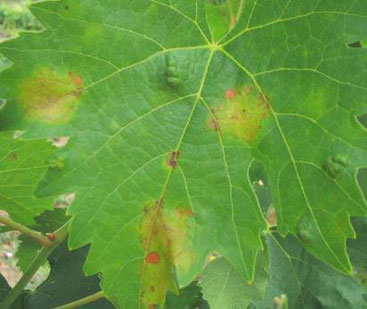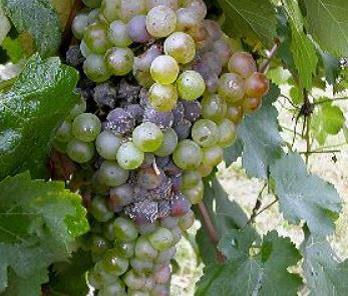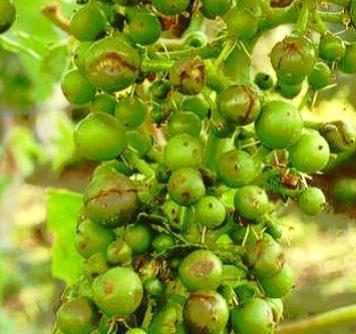- WHAT IS BIOLOGICAL AGRICULTURE?
- CORROBORANT - AMENDANT
- WHAT ARE ZEOLITITE CHABASITE?
- WHY USE ZEOLITE?
- ZEOLITE CHABASITE EXTRACTION
- APPLICATIONS - ZEOLITE
- BENEFITS OF ZEOLITE CHABASITE - VINEYARDS - ORCHARDS
- ZEOLITE CHABASITE GRASS CARPETS
- ZEOLITE CHABASITE WATER PURIFICATION
- PRODUCTS
- GRAFTED CUTTING
- SERVICE-VINEYARD PLANTING
- DISEASES IN THE VINEYARD
- VITIS VINIFERA
- CONTACT
BENEFITS OF ZEOLITE A CHABASITE IN VITICULTURE
In this section our agronomist Gianluca Peirano, has produced protocols for different situations in the vineyard with different cases of disease attacks on the vine: we remember
that in every region of Italy, each vineyard has its own characteristics that a personalized protocol is drawn up based on many factors that influence your system. There is no
manual from the North to the South (for the factors listed above) but we follow the needs linked to the territory !!
PERONOSPORA Plasmopara Viticola

The affected leaves become necrotic and fall precociously, while the inflorescences, which are extremely sensitive to the pathogen, yellow and then necrotize taking the typical "S" shape and dry out. In the bunch, instead, between the setting phase and the closing clusters, in conditions of low humidity there is a manifestation of the pathology with browning and partial or total drying of berries and bunches that usually take on a "hook" shape
CONSIDERATIONS FOR END OF TREATMENT
From the data collected during the field trials and the subsequent tests with the direct users of the product, it is stated with technical and photographic data that in a plot treated with
chabasite the following is denoted:
· GENERAL INCREASE OF THE HEALTH OF THE PLANT
· CONTAINMENT OF THE FIRST INFECTION OF 70%
· CONTAINMENT OF THE SECOND INFECTION OF 100%
· TOTALLY TRAPS AND GRAPPLE DISEASES FROM DISEASE
OIDIO

Formation of a whitish felt and powdery appearance, present on the surface of the affected organs, due to the interweaving of the emission hyphae and the spores. The organs most frequently affected are herbaceous leaves and buds, more rarely the fruits in growth.
During the attacks the affected areas undergo a visible discoloration in the first stage already removing the mycelium, then the tissue necrosis appears. In the last stage, desiccation and splitting occurs (the latter on the fleshy organs). These splits can easily favor the onset of diseases such as Botrite.
CONSIDERATIONS FOR END OF
TREATMENT
From the data collected during the field trials and the subsequent tests with the direct users of the product,
it is stated with technical and photographic data that in a plot treated with chabasite the following is denoted:
· GENERAL INCREASE OF THE HEALTH OF THE PLANT
· CONTAINMENT OF THE FIRST 80% INFECTION
· CONTAINMENT OF 100% INFECTION OF SECOND TREATMENT
-TRANS AND GRAPES TOTALLY CLEANED BY
ILLNESS
BOTRITE

Causes two types of infections:
· Gray rot: it occurs in maturation and requires a constant condition of soil moisture or a high humidity level in the atmospheric air. Infection causes the fall of infected clusters.
-Mobile noble: It occurs in hot and dry conditions, wet conditions alternate because of morning dew or sporadic rainy events; these favor a limited diffusion of the fungus which
increases the drying and the sugar degree of the grapes without causing excessive damage (particularly useful in the production of high quality liqueur wines.
CONSIDERATIONS FOR END OF TREATMENT
From the data collected during the field trials and the subsequent tests with the direct users of the product, it is stated with technical and photographic data that in a plot treated with
chabasite the following is denoted:
· GENERAL INCREASE OF THE HEALTH OF THE PLANT
· CONTAINMENT OF 80% INFECTION
· COMPLETELY DRY AND CICATRIZED WOUNDS
· TRAITS AND GRAPPOLI ALMOST TOTALEMS CLEANED BY DISEASE
DAMAGE FROM GRANDINE

Physically little to say about an event like this except that they are non-controllable calamitous damage. The appearance of such can promote the emergence of diseases such as B.Cinerea and Oidium with an exponential increase in loss of production. It is possible to limit this problem with green pruning techniques where the topping will be limited to slow down the fall of the grains or with the laying directly of anti hail nets.
CONSIDERATIONS FOR END OF TREATMENT
From the data collected during the field trials and the subsequent tests with the direct users of the product, it is stated with technical and photographic data that in a plot treated with
Chabasite the following is denoted:
· GENERAL INCREASE OF THE HEALTH OF THE PLANT
· 80% INFECTION OF THE INFECTION
· COMPLETELY DRY AND CICATRIZED WOUNDS
-TRANS AND GRAPES ALMOST EVERYTHING CLEANED BY ILLNESS
HAZENUTS

Presence of ovations on the lower page of the leaves. The most noticeable damages are the bites of the fruits (general damage on all crops) that growing and maturing present from before the malformations and then the decay of the pulp around the area of the puncture with relative loss of the fruit for the "cimicato"
CONSIDERATIONS FOR END OF TREATMENT
From the data collected during the field trials and the subsequent tests with the direct users of the product, it is stated with technical and photographic data that in a plot treated with
Chabasite the following is denoted:
· GENERAL INCREASE OF THE HEALTH OF THE PLANT
· CONTAINMENT OF THE FIRST GENERATION OF 70%
· CONTENT OF THE SECOND GENERATION OF 70% IF USED PURE, ASSOCIATING THE
- TREATMENT TO INSECTICIDES OR GREASY ALCOHOLES ENHANCES THE ABOVE EFFECT WITH AN INCREASE OF THE LICENSE OF THE PRODUCT.
FRUITCULTURE


CONSIDERATIONS FOR END OF TREATMENT
From the data collected during the field trials and the subsequent tests with the direct users of the product, it is stated with technical and photographic data that in a plot treated with
Chabasite the following is denoted:
· GENERAL INCREASE OF THE HEALTH OF THE PLANT
· CONTAINMENT OF THE FIRST GENERATIONS OF 70%
· CONTAINING THE SECOND GENERATION OF ABOUT 50-70% AS A PURE TREATMENT, TREATMENT BECOMES MORE EFFECTIVE IF ASSOCIATED WITH INSECTICIDE OR PYRETROIDS OR NATURAL ALCOHOL
PRODUCTS
VIGNA TECH SRLS
REGIONE DOTA N.28 - 14053 CANELLI (AT)
CONTATTI:
+39.328.146.9772
+39.375.616.8405
accessoripervigneti@vignatech.it
C.F. E P.IVA 01623950050

